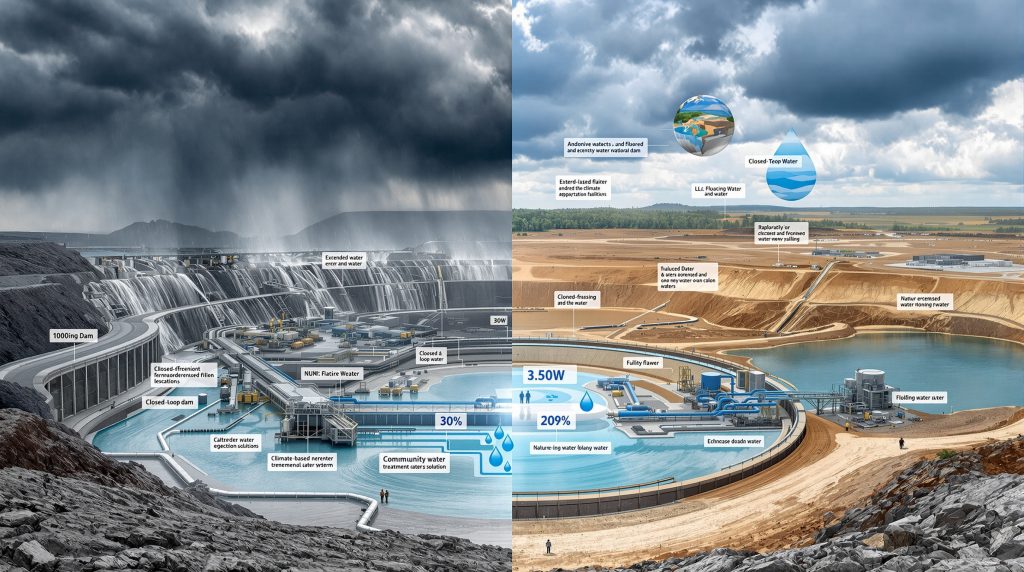Adapting Water Engineering in Mining for Climate Change Challenges
Climate change is fundamentally altering precipitation patterns worldwide, creating dual challenges for mining operations through increasingly frequent droughts and more intense rainfall events. These shifting weather patterns undermine traditional water management approaches that historically relied on statistical data for future projections. As weather becomes more unpredictable, mining companies must develop sophisticated forecasting models and implement adaptive engineering solutions to maintain operational continuity while meeting increasingly stringent environmental compliance requirements.
According to Tiaan Bauman, partner and principal civil engineer at SRK Consulting South Africa, "Traditional water management design approaches that relied on historical rainfall and weather data for future projections are no longer sufficient due to climate change and rainfall variability." This highlights the urgent need for mining operations to rethink their water engineering strategies.
The Evolving Water Landscape for Mining Operations
Mining processes, particularly mineral processing, require substantial water volumes to facilitate effective extraction. For context, metal ore processing typically requires 500-2,000 gallons per ton of ore processed, while some gold extraction methods can use up to 8,000 gallons per ounce of gold produced.
Many global mining regions coincide with historically low-rainfall areas, creating inherent water supply challenges that climate change is now amplifying. This is particularly evident in South Africa, where mining regions are often located in provinces with relatively low annual rainfall.
Climate variability now disrupts traditional water management approaches that relied on statistical averages and historical patterns. The increasing frequency of both droughts and floods requires more dynamic and resilient water systems.
Engineering solutions must simultaneously address both water scarcity during extended dry periods and manage excess water during increasingly intense rainfall events – a complex balancing act requiring significant technical expertise and investment.
What Water Scarcity Challenges Do Mines Face Under Climate Change?
Mining operations require consistent water access for mineral processing, yet climate change is extending dry periods and intensifying drought conditions in many mining regions. This necessitates expanded water storage capacity and alternative supply strategies to maintain operational continuity during prolonged dry spells.
"Dry spells can turn into drought conditions more frequently than expected, necessitating expanded storage capacity," notes Bauman. This shift is driving mining companies to reconsider their entire approach to water sourcing and storage.
Strategic Approaches to Water Scarcity
The mining industry is implementing several key strategies to address water scarcity:
- Expanded water retention facilities to capture and store rainfall during wet periods for use during dry spells
- Reduced dependence on increasingly unreliable and costly municipal water sources
- Implementation of water recycling systems within processing circuits to minimize freshwater requirements
- Development of alternative water sources including treated wastewater, seawater (for coastal operations), and groundwater
These approaches require significant engineering expertise and capital investment but are increasingly viewed as operational necessities rather than optional sustainability transformation initiatives.
Case Study: Water Self-Sufficiency Initiatives
South African mining companies are increasingly pursuing water self-sufficiency through innovative approaches:
| Strategy | Implementation Example | Benefit |
|---|---|---|
| Water Treatment | Coal mines in Mpumalanga upgrading mine water to potable standards | Reduced municipal demand while creating community water source |
| Process Water Recycling | Closed-loop systems in processing plants | Minimized freshwater requirements |
| Collaborative Solutions | Multi-mine water treatment facilities | Economies of scale for treatment costs |
These initiatives demonstrate how mining companies are adapting to water scarcity while potentially creating shared value for surrounding communities. As Bauman notes, "The focus for mines is to draw as little water as possible from traditional municipal sources and work towards self-sufficiency, especially given water shortages faced by many South African municipalities."
How Are Extreme Rainfall Events Threatening Mining Operations?
While droughts present one challenge, increasingly frequent intense rainfall events create opposite but equally problematic conditions. Heavy downpours can rapidly overwhelm water management infrastructure, potentially leading to uncontrolled discharges, dam breaches, and environmental contamination.
According to engineering experts, these events pose significant operational, environmental, and reputational risks for mining companies. Higher-than-usual rainfall intensity can quickly result in return water dams and settlement ponds filling up and overtopping, potentially causing non-compliant discharges into the surrounding environment.
Engineering Challenges from Increased Rainfall Intensity
Mining operations face several critical challenges from more intense rainfall:
- Return water dams and settlement ponds reaching capacity faster than designed for historical rainfall patterns
- Higher risk of infrastructure failure during extreme weather events exceeding design parameters
- Potential for non-compliant water discharges into surrounding environments, leading to regulatory penalties and reputational damage
- Increased erosion and sediment management requirements throughout the mine site
These challenges require mining companies to reconsider the design parameters and safety factors used in their water management infrastructure.
Critical Infrastructure Vulnerabilities
The Global Industry Standard on Tailings Management (GISTM) now explicitly requires consideration of climate change impacts on tailings storage facilities (TSFs) and associated water management infrastructure. This has prompted comprehensive reviews of:
- TSF design parameters and safety factors to accommodate more extreme weather events
- Return water dam capacity and overflow systems to handle increased water volumes
- Water diversion structures and stormwater controls to manage altered flow patterns
- Emergency response protocols for extreme weather events that may exceed design capacities
Leading mining companies have invested considerably in reviewing their TSF design and management, as well as associated infrastructure such as return water dams, to ensure they can withstand changing climate conditions.
What Regulatory Standards Are Driving Water Engineering Changes?
Strict regulatory frameworks govern water management in mining operations, with significant penalties for non-compliance. Climate change considerations are increasingly being incorporated into these requirements, creating additional compliance challenges.
According to water engineering experts, ensuring compliance with evolving regulations is becoming more complex as climate change alters the baseline conditions upon which many standards were originally developed.
Key Regulatory Drivers
Several regulatory factors are influencing water engineering decisions:
- Water discharge quality standards for controlled releases, which must be met regardless of changing climate conditions
- Zero-discharge requirements during certain periods or in sensitive watersheds
- GISTM requirements for climate change consideration in tailings management
- Financial assurance requirements for water-related infrastructure that must account for climate risks
These regulations create a framework that increasingly requires mining companies to incorporate climate change considerations into their water management planning and infrastructure design.
Compliance Consequences
Non-compliant discharges into the environment or dam breaches can lead to costly fines and even more significant reputational damage. This makes water management not just an operational concern but a material business risk that must be addressed at the highest levels of corporate governance.
For mining companies, particularly those with operations in environmentally sensitive areas or near communities, maintaining water quality standards and preventing uncontrolled discharges is essential for maintaining their social license to operate.
How Are Advanced Water Treatment Technologies Transforming Mining?
Water treatment technologies are enabling mines to reduce freshwater consumption, minimize environmental impacts, and potentially create additional value streams through water provision to communities. These technologies represent a significant area of innovation and investment within the mining waste management sector.
"Various water treatment technologies are available, including desalination of seawater by coastal mining operations, though many can be costly," notes Bauman. Despite these costs, companies are increasingly recognizing that securing appropriate water quality and quantity is becoming more expensive due to population and economic growth alongside climate pressures.
Innovative Treatment Approaches
The mining industry is implementing several advanced treatment technologies:
- Advanced filtration systems for process water recycling, including membrane technologies
- Passive treatment systems for long-term water management, such as constructed wetlands
- Desalination technologies for coastal operations facing freshwater constraints
- Treatment of mine water to potable standards for community use or municipal supply
These technologies allow mining companies to improve water efficiency, reduce environmental impacts, and potentially transform water from an operational challenge into a community benefit.
Cost Considerations
While treatment technologies offer significant benefits, they also represent substantial investments:
| Treatment Approach | Relative Cost | Application Scenario |
|---|---|---|
| Basic Filtration | Low-Medium | Process water recycling |
| Reverse Osmosis | Medium-High | Treating brackish mine water |
| Desalination | Very High | Coastal operations with limited freshwater |
| Advanced Chemical Treatment | High | Addressing specific contaminants |
The economics of water treatment are evolving as technology improves and as the costs of water scarcity and regulatory non-compliance increase. For many mining operations, advanced water treatment is increasingly viewed as a necessary investment rather than an optional extra.
Why Is Water Stewardship Becoming Essential for Mining Operations?
Water stewardship approaches recognize that water management extends beyond mine boundaries and requires consideration of broader catchment conditions and stakeholder needs. This holistic approach is increasingly vital for maintaining social license to operate.
"Water stewardship provides strategies for considering the broader catchment around a mine, including stakeholders like communities and other industries," explains Bauman. This approach acknowledges that water is a shared resource and that mining operations impact and are impacted by the broader watershed context.
Water Stewardship Principles
Several key principles define the water stewardship approach:
- Catchment-level water management planning that considers all users and ecosystem needs
- Stakeholder engagement in water allocation decisions to ensure fair and transparent processes
- Recognition of community water needs and priorities in operational planning
- Collaborative approaches to regional water challenges that leverage shared resources and expertise
By adopting these principles, mining companies can build more sustainable and resilient water management systems while strengthening relationships with local communities and regulators.
Social License Considerations
"A key factor guiding water engineering options is mines' relationships with their local communities, which is really the basis of their social licence to operate," notes Bauman. This recognition highlights how water management has evolved from a purely technical engineering challenge to a critical aspect of stakeholder relations and corporate social responsibility.
For mining operations, particularly in water-stressed regions, demonstrating responsible water management is increasingly essential for maintaining community support and regulatory approval.
How Can Mines Balance Operational Needs with Community Water Security?
Mining operations must increasingly balance their operational water requirements with the needs of surrounding communities, particularly in water-stressed regions where competition for resources is intensifying. This balancing act requires both technical solutions and stakeholder engagement approaches.
According to water scarcity and climate change experts, mines recognize the need to balance their own water demands with those of surrounding towns and settlements. This recognition is driving innovative approaches to water management that consider both operational and community needs.
Community Water Security Strategies
Several strategies are helping mining operations contribute to community water security:
- Minimizing extraction from shared water sources to reduce competition with community needs
- Treating and providing water for community use where feasible, turning an operational byproduct into a community resource
- Transparent communication about water usage and management to build trust and understanding
- Investment in community water infrastructure to improve overall water security in the region
These strategies reflect a growing recognition that mining companies have both a responsibility and an opportunity to contribute positively to water security in their host communities.
Collaborative Approaches
Some mining companies are going beyond compliance to actively contribute to community water security:
- Treatment of mine water to potable standards for municipal use, as demonstrated by coal mines in Mpumalanga
- Infrastructure investments to reduce community water losses through improved distribution systems
- Watershed protection initiatives to improve water quality and availability for all users
- Knowledge sharing on water conservation techniques that can benefit both mine operations and community water users
These collaborative approaches can create shared value while helping mining companies secure their social license to operate in water-stressed regions.
What Engineering Innovations Are Addressing Climate Resilience?
The mining sector is developing innovative engineering approaches to enhance climate resilience in water management systems, addressing both water scarcity and excess water challenges. These innovations combine advances in materials science, digital technologies, and system design.
Engineering experts note that consultants are working not only to ensure latest standards are applied but to push boundaries of the discipline to evolve innovative ways to more effectively meet these standards. This innovation drive is essential for developing water management systems that can withstand increasing climate variability.
Emerging Engineering Solutions
Several key innovations are improving the climate resilience of mining water systems:
- Climate-adaptive water storage designs that can accommodate greater variability in rainfall patterns
- Real-time monitoring and predictive management systems that enable proactive responses to changing conditions
- Flexible water infrastructure that can adapt to changing conditions through modular design and operational adjustments
- Nature-based solutions for water management that leverage ecosystem services for filtration, storage, and flow regulation
These innovations are helping mining companies develop more resilient water management systems that can withstand the increasing variability and uncertainty associated with climate change.
Research and Development Priorities
Leading mining companies are investing in research to advance water engineering practices:
- Improved climate modeling for mining regions to enhance predictive capacity
- More efficient water treatment technologies that reduce energy consumption and operational costs
- Automated water management systems that optimize water use and storage based on real-time conditions
- Integration of renewable energy with water infrastructure to reduce carbon footprint and operating costs
As Bauman notes, "Engineering interventions are becoming increasingly essential, requiring fostering of necessary research and development to optimize strategies." This research and development work is critical for developing the next generation of climate-resilient water management solutions.
How Should Mines Prepare Water Systems for Future Climate Uncertainty?
Given the uncertainty surrounding future climate conditions, mining operations must adopt adaptive management approaches that can respond to a range of potential scenarios while maintaining operational continuity and environmental compliance.
Water engineering experts emphasize that traditional approaches based solely on historical data are no longer sufficient. Instead, mining companies must develop systems that can accommodate a wider range of potential climate futures.
Adaptive Management Strategies
Several key strategies can help mining operations prepare for climate uncertainty:
- Scenario-based planning for multiple climate futures, considering both wetter and drier conditions
- Modular infrastructure that can be expanded or modified as needed to accommodate changing conditions
- Regular reassessment of climate projections and water risks to ensure continued system adequacy
- Incorporation of climate uncertainty into financial planning, including capital expenditure and operational budgeting
These strategies enable mining companies to develop water management systems that can evolve over time in response to changing climate conditions and improved understanding of climate impacts.
Implementation Challenges
Smaller mining operations often face resource constraints that limit their ability to implement comprehensive climate adaptation measures. As Bauman notes, "Improvements to water-related infrastructure place a financial burden on mining, with smaller mining companies often less well-resourced to make necessary investments in sustainable and resilient solutions."
Industry collaboration and knowledge sharing can help address these challenges:
- Shared research initiatives on climate impacts that pool resources across multiple companies
- Industry-wide standards for climate-resilient design that provide clear guidance for all operators
- Collaborative infrastructure for regional water management that creates economies of scale
- Technology transfer to smaller operations through industry associations and government programs
These collaborative approaches can help ensure that all mining operations, regardless of size, can develop climate-resilient water management systems.
FAQ: Mining Water Management and Climate Change
How much water does a typical mining operation use?
Water usage varies significantly by mineral type and processing method. Metal ore processing typically requires 500-2,000 gallons per ton of ore, while some gold extraction methods can use up to 8,000 gallons per ounce of gold produced. Recycling rates also vary widely, with best-practice operations recycling 60-80% of process water.
What water quality standards must mines meet for discharge?
Discharge standards vary by jurisdiction but typically regulate pH, total suspended solids, dissolved metals, and other contaminants. Many regions are implementing increasingly stringent standards that approach drinking water quality for certain parameters. In South Africa, these standards are governed by specific environmental regulations that require careful monitoring and treatment.
How are tailings facilities affected by climate change?
Climate change impacts tailings facilities through increased rainfall intensity (risking overtopping), extended dry periods (causing dust issues), and extreme weather events (threatening structural integrity). The GISTM now requires explicit consideration of these climate factors in design and management, leading many mining companies to reassess and upgrade their tailings facilities.
What is water stewardship in the mining context?
Water stewardship involves managing water resources responsibly within the broader catchment context, considering the needs of all stakeholders and working collaboratively to ensure water security for operations and communities alike. This approach extends beyond compliance to consider how mining operations can contribute positively to watershed health and community water security.
How can mines reduce their freshwater consumption?
Mines can reduce freshwater consumption through process water recycling, capturing and treating site runoff, implementing water-efficient technologies, and exploring alternative water sources such as treated wastewater or seawater. Leading operations have achieved reductions of 30-50% in freshwater withdrawal through comprehensive water efficiency programs.
Further Exploration
Readers interested in learning more about water management in mining operations can explore related educational content available on industry websites, which offer additional perspectives on sustainable mining practices and environmental management. Professional organizations such as the International Council on Mining and Metals (ICMM) also provide valuable resources on water stewardship in the mining sector.
As mines water engineering climate change continues to alter precipitation patterns worldwide, the mining industry's approach to water engineering will remain an evolving field requiring continuous innovation, investment, and collaboration. By adopting proactive, adaptive approaches to water management, mining companies can enhance their operational resilience while contributing positively to community water security.
Furthermore, understanding the industry evolution trends and implementing mine reclamation innovation alongside data‑driven operations will be essential for mining companies seeking to navigate the complex challenges posed by climate change while maintaining both operational efficiency and environmental responsibility.
Want to Discover Promising Mining Investments Before the Market Does?
Discover how major mineral findings can lead to exceptional investment returns by exploring Discovery Alert's dedicated discoveries page, powered by their proprietary Discovery IQ model. Visit https://discoveryalert.com.au/discoveries/ today to begin your 30-day free trial and position yourself ahead of the market for the next significant ASX mineral discovery.




